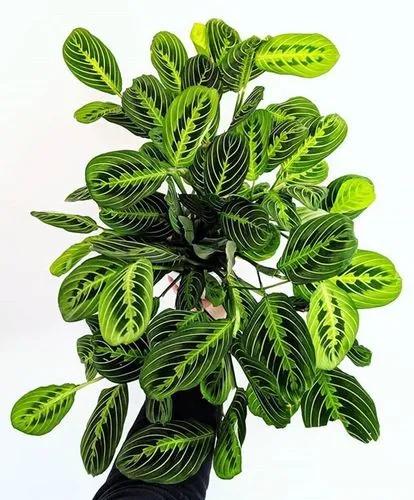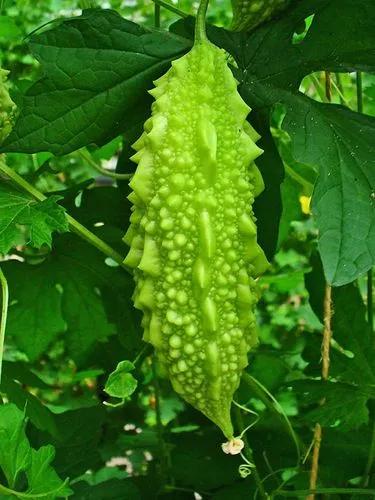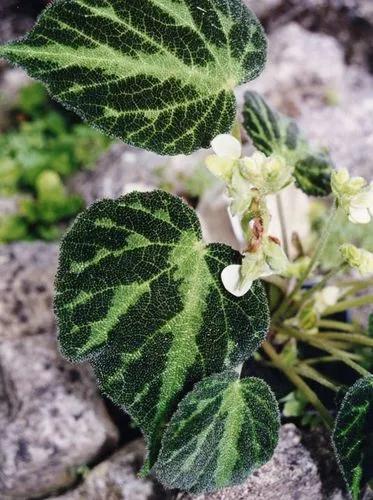Herb c. 20–60 cm tall. Stem epigeal, erect to decumbent, 1.5–2 cm diam., with internodes 1–3 cm long, pleionanthic. Leaves several in a terminal cluster; petiole 12–27 cm long, usually glabrous, occasionally sparsely to densely and minutely pubescent, sheathing in the lower ½–¾; wings of sheath fully attached, tapering, persistent to slowly degrading in the marginal distal part; blade (broadly oblanceolate to) oblonglanceolate to narrowly ovate, usually rather distinctly asymmetric, bright to midgreen, sometimes suffused with purple and/or purple-backed, adaxially sometimes variegated with sparse to dense irregular grey-green spattering, 16–31 cm long × 3–8 cm wide, the base (acute to) obtuse to emarginate (to very shallowly cordate), the tip acute to long-acuminate; midrib slightly prominent abaxially (dry) or not, with 6–13 primary lateral veins on each side, more or less regularly alternating with lesser interprimaries and diverging at 45–60(–70)°; secondary venation arising mainly from the midrib; tertiary venation obscure. Inflorescences to 4 together, subtended by lanceolate cataphylls sometimes bearing long mucros (reduced petiole) or reduced petioles and blades; peduncle to c. 8 cm long. Spathe 8.5–10.5 cm long, green to suffused dark red; lower spathe 2.5–4 cm long, ovoid to narrowly ovoid, differentiated from the limb by a rather gradual constriction; limb 6–7.5 cm long, oblong-lanceolate, often with the margins not overlapping and exposing part of the male zone and appendix on the ventral side in bud, hardly opening at anthesis then persistent, finally degrading and falling with the spent parts of the spadix. Spadix sessile, 7.3–9.4 cm long, subcylindric; female zone 1.8–2.3 cm long, adnate to the spathe in the lower 0.7–1 cm, 5–7 mm thick at the middle, slightly conic in the distal half; pistils slightly lax to densely crowded, oblong to ovoid to bottle-shaped, c. 0.7–1 mm diam.; stigma variable, sessile to elevated on a short style, punctate to button-like to discoid, 0.3–0.8 mm diam., papillate, when pistils dense and stigma large then adjacent stigmas contiguous, when pistils lax and stigmas small then adjacent stigmas wide-spaced (+ intermediate states); interpistillar staminodes 0–very few among the pistils, 0–few at the base of the female zone (clustered on the ventral side forming an incomplete basal row), concentrated at the interface of the female zone and the sterile interstice, sessile to stalked, lower than to 1.5 times the height of the ovary, the heads more or less rounded, c. 0.5 mm diam.; sterile interstice 0.7–1.4 cm long, slightly attenuate, held within and reaching the mouth of the lower spathe chamber, partly naked with scattered groups of interpistillar staminodes in the naked part, the distal part composed of (1–)2–8 irregular dense whorls of sterile anthers at the base of the male zone; male zone 0.9–2.2 cm long, 4–7 mm thick at the top, subcylindric to faintly obconic; stamens crowded, truncate, weakly dumbbell-shaped (irregularly rectangular) with the connective rather thick but not or hardly exceeding the thecae, c. 0.8 mm across; appendix 2.6–3.5 cm long, subcylindric and apically obtuse to fusiform and apically acute, 5–8 mm diam.; staminodes of the appendix flat-topped, irregularly polygonal, c. 1–1.5 mm diam. Fruiting peduncle not or hardly elongating; fruiting spathe urceolate, c. 3–5 cm long.
Apoballis Care
Apoballis acuminatissima 'Lavallaei'



How to Care for the Plant

Water

Water every week in the summer and every two-three weeks in the cooler months, generally keep moist but not overly wet or too dry.

Fertilizer

Use a common slow-release fertilizer three times a year and a low-strength balanced fertilizer once a month during the growing period to help encourage strong growth.

Sunlight

Moderate light, avoid direct sunlight as leaves with burn.

Soil

Plant into well-draining potting mix with some perlite added.

Temperature

Generally, typical household temperatures and humidity levels are fine for these plants.

Container

Plant pictured is approx. 20cm tall and wide in a 170mm pot.

Popularity

96 people already have this plant 7 people have added this plant to their wishlists
Discover more plants with the list below
Popular articles






